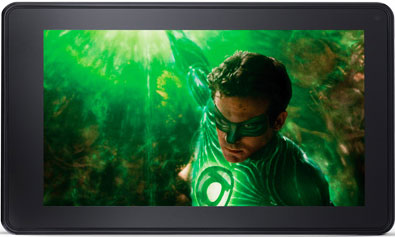How Much Money is Amazon Losing on the Kindle Fire Tablet?
Amazon's Kindle Fire tablet figures to be a hugely successful device. How much of a success is yet to be determined, but there's certainly a lot of buzz surrounding Amazon's entry into the tablet market. That's what happens when you undercut the competition with a $199 slate without neutering the hardware. Sure, it's a 7-inch slate, but it's also rocking a dual-core processor, 512MB of RAM, and an IPS panel. In fact, some estimates have the hardware and manufacturing costs coming out to more than $199.
IHS iSuppli, for example, put together an estimated bill of materials (BOM) that has Amazon spending $209.63 on each Kindle Fire tablet. The most expensive parts are the display/touchscreen ($87) and main PCB ($70.40). After those items, everything costs $25 or less.

Now get this. According to eDataSource, Amazon racked up 95,000 Kindle Fire pre-orders on the first day it was available for purchase. If Amazon's losing $10 per device, that means it's already in the hole for $950,000! Of course that's chump change for Amazon, and eDataSource notes that 27 percent of Kindle Fire buyers also purchased an accessory to go along with it, so the online retailer has already recouped some of its hardware-related losses.
Amazon won't make its money back on accessories alone, and according to IHS iSuppli, the content demand the Kindle Fire stimulates will ultimately promote sales of other physical goods, thinks like shoes and diapers.

"Similar to Walmart and other large brick-and-motor retailers, Amazon’s content business is designed to lure in consumers to buy such everyday goods as well as other money-making items," IHS iSuppli says. "The importance of this strategy cannot be underestimated. So far, no retailer has managed to create an umbilical link between digital content and a more conventional retail environment. With Kindle, Amazon has created the most convincing attempt at this yet, and it is doing so by using established retail tactics: deploying content to get shoppers in the door, and then selling them all sorts of other goods. This is exactly how Walmart, Target and others use a similar weapon—in their case, DVDs. If doing this means that Amazon must take a loss on the sales of digital content and tablet hardware, it will be well worth it in the end."
That's an interesting theory, and IHS iSuppli says it's a business model unique to Amazon. How so? Well, no other tablet manufacturer or eBook vendor operates the same large-scale retail service as Amazon does, which sells almost everything under the sun.
IHS iSuppli, for example, put together an estimated bill of materials (BOM) that has Amazon spending $209.63 on each Kindle Fire tablet. The most expensive parts are the display/touchscreen ($87) and main PCB ($70.40). After those items, everything costs $25 or less.

Now get this. According to eDataSource, Amazon racked up 95,000 Kindle Fire pre-orders on the first day it was available for purchase. If Amazon's losing $10 per device, that means it's already in the hole for $950,000! Of course that's chump change for Amazon, and eDataSource notes that 27 percent of Kindle Fire buyers also purchased an accessory to go along with it, so the online retailer has already recouped some of its hardware-related losses.
Amazon won't make its money back on accessories alone, and according to IHS iSuppli, the content demand the Kindle Fire stimulates will ultimately promote sales of other physical goods, thinks like shoes and diapers.

"Similar to Walmart and other large brick-and-motor retailers, Amazon’s content business is designed to lure in consumers to buy such everyday goods as well as other money-making items," IHS iSuppli says. "The importance of this strategy cannot be underestimated. So far, no retailer has managed to create an umbilical link between digital content and a more conventional retail environment. With Kindle, Amazon has created the most convincing attempt at this yet, and it is doing so by using established retail tactics: deploying content to get shoppers in the door, and then selling them all sorts of other goods. This is exactly how Walmart, Target and others use a similar weapon—in their case, DVDs. If doing this means that Amazon must take a loss on the sales of digital content and tablet hardware, it will be well worth it in the end."
That's an interesting theory, and IHS iSuppli says it's a business model unique to Amazon. How so? Well, no other tablet manufacturer or eBook vendor operates the same large-scale retail service as Amazon does, which sells almost everything under the sun.

